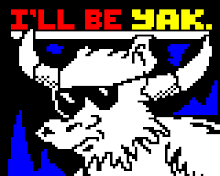 Though from the mid 1970s, these screenshots of early teletext systems do not differ wildly from those we see today. This is due to the medium, in many ways completely unlike the Internet, staying essentially the same throughout this time despite a number of upgrades and add-ons. Thus it may be said that the design of Teletext is distinctly outdated - and in many ways this is correct. Though cutting edge at the time of its invention, the medium's look can be seen as inferior to the Internet, which has largely taken over the role teletext once had.
Though from the mid 1970s, these screenshots of early teletext systems do not differ wildly from those we see today. This is due to the medium, in many ways completely unlike the Internet, staying essentially the same throughout this time despite a number of upgrades and add-ons. Thus it may be said that the design of Teletext is distinctly outdated - and in many ways this is correct. Though cutting edge at the time of its invention, the medium's look can be seen as inferior to the Internet, which has largely taken over the role teletext once had.Having said this, it is noticeable that the BBC Sport service (www.bbc.co.uk/sport ) utilises the same text for both its Ceefax and website broadcasts, meaning there is no difference in content as such here. This outlines an important aspect of the service - just getting across the bare facts is what people want in the world of Internet surfing. People generally don't have the time or patience to read reams of text: if they want to do this they would buy the Times or similar broadsheet or publication.
 The first two images in this post are from BBC's Ceefax service in 1975. The first is a promotional postcard displaying the layout of the front page at that time. Note the 70s 'Bauhaus'-style sans serif font. Meanwhile, left is one of the earliest examples of teletext 'art' in the form of a weather map of Britain. As has been previously stated, this design is not all that different from the teletext maps of today - the same visual metaphor has survived for thirty years. This further shows that a simple but effective design can stand the test of time, so to speak.
The first two images in this post are from BBC's Ceefax service in 1975. The first is a promotional postcard displaying the layout of the front page at that time. Note the 70s 'Bauhaus'-style sans serif font. Meanwhile, left is one of the earliest examples of teletext 'art' in the form of a weather map of Britain. As has been previously stated, this design is not all that different from the teletext maps of today - the same visual metaphor has survived for thirty years. This further shows that a simple but effective design can stand the test of time, so to speak. Right is a screenshot of an experimental version of Ceefax in 1975. This is uniform in colour, pretty much 100% text and can be put on a similar level to ASCII art on the Internet today. Consisting of just thirty pages, the test run was very much a precursor to the visual text-art designs used today on Teletext and to a lesser extent the Internet.
Right is a screenshot of an experimental version of Ceefax in 1975. This is uniform in colour, pretty much 100% text and can be put on a similar level to ASCII art on the Internet today. Consisting of just thirty pages, the test run was very much a precursor to the visual text-art designs used today on Teletext and to a lesser extent the Internet. Left is a character map from an Oracle system in 1976, when a series of new characters were added to the set:
Left is a character map from an Oracle system in 1976, when a series of new characters were added to the set:"The handful of glyphs which were introduced with the Tifax ROM together with a few others, such as the "£", "$" and "@" signs were specific to the UK Character Set. Later specifications allowed for a further seven international variants so that accented characters and currency symbols could be accommodated."
Links:
http://www.pembers.freeserve.co.uk/Teletext/Photographs.html - Early days of teletext
http://en.wikipedia.org/Teletext - Brief history and technical aspects of teletext


0 comments:
Post a Comment